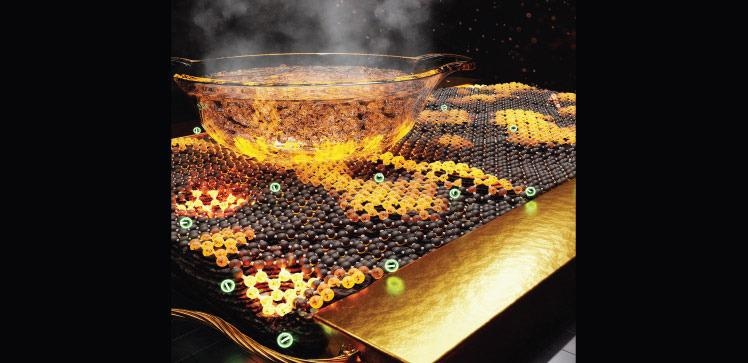When multiple carbon nanomaterials are combined in a single substance, unexpected properties emerge. Scientists at KAUST have developed thin graphite films that could be used as high-performance flexible heater panels, attaining temperatures of several hundred degrees in seconds when a low voltage is applied.
 A new nanoscale-thick graphite film can reach 300 °C within seconds when applying just 8 volts, significantly lower than current nanocarbon-based heaters. Image Credit: © 2022 KAUST; Hassan Tahini. Artwork for ACS Applied Materials and Interfaces journal cover, American Chemical Society.
A new nanoscale-thick graphite film can reach 300 °C within seconds when applying just 8 volts, significantly lower than current nanocarbon-based heaters. Image Credit: © 2022 KAUST; Hassan Tahini. Artwork for ACS Applied Materials and Interfaces journal cover, American Chemical Society.
They also discovered that graphene domains within the graphite film are the crucial component of the material’s exceptional heating performance.
Graphitic carbon nanomaterials are intensely used for heat management, for instance, to dissipate heat from microchips because they are excellent thermal conductors. Electric heaters could be made from the same materials.
There’s a need to develop low-power, flexible heater panels, and nanocarbons are key contenders. So far, however, their electrothermal performance has been limited.
Geetanjali Deokar, Postdoc, King Abdullah University of Science and Technology
Deokar, a postdoc in Pedro Costa’s laboratory, headed the study.
Nanocarbon-based heaters typically require a 20–60 volt input to reach a target temperature of 250 °C. When heated in the air, they degrade quickly.
Costa, Deokar, and their colleagues recently created a wafer-scale method for producing nanoscale-thick graphite films (NGFs). They were also able to transfer them to arbitrary substrates without leaving residue, which is common in graphene panels.
These characteristics of the NGF prompted us to investigate their application in thermal management technologies.
Geetanjali Deokar, Postdoc, King Abdullah University of Science and Technology
The team discovered that when NGFs were placed on flexible Kapton sheets with gold electrodes, their heater performance was much better than earlier described nanocarbon heaters. The material reached a target temperature of 300 °C in seconds using less than 8 volts. Cooling was also quick.
Deokar remarked, “We also observed outstanding stability and showed the NGF could be used as an external reusable patch to boil water.”
We operated them at double the maximum temperature of other nanocarbons (with roughly half the power input) and the useful heating area was also augmented, meaning the efficiency of the panel was considerably better.
Pedro Da Costa, King Abdullah University of Science and Technology
The material’s possible applications range from tiny heaters for sensors or microfluidic devices to large-scale heaters like aviation defoggers or space heat regulators.
The NGF’s incredible performance, according to the team, is because of the presence of wrinkles and graphene domains in the material, which function as hotspots.
Deokar added, “These structural features are distributed all over the NGF surface, explaining the high temperatures and uniform heat spread.”
Even though wrinkles can be found in other nanoscale-thick graphite films, the NGFs have graphene domains that are distinct.
Pedro concludes, “The presence and function of the graphene domains is something that we want to better understand.”